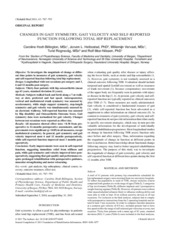| dc.contributor.author | Hodt-Billington, Caroline | en_US |
| dc.contributor.author | Helbostad, Jorunn L. | en_US |
| dc.contributor.author | Vervaat, Willemijn | en_US |
| dc.contributor.author | Rognsvåg, Turid | en_US |
| dc.contributor.author | Moe-Nilssen, Rolf | en_US |
| dc.date.accessioned | 2012-03-14T10:06:51Z | |
| dc.date.available | 2012-03-14T10:06:51Z | |
| dc.date.issued | 2011-09 | eng |
| dc.identifier.issn | 1650-1977 | |
| dc.identifier.uri | https://hdl.handle.net/1956/5710 | |
| dc.description.abstract | Objective: To investigate the magnitude of change at different time points in measures of gait symmetry, gait velocity and self-reported function following total hip replacement. Design: Longitudinal with test occasions pre-surgery and 3, 6 and 12 months post-surgery. Subjects: Thirty-four patients with hip osteoarthritis (mean age 63 years, standard deviation 11 years). Methods: Subjects walked back and forth along a 7-m walkway at slow, preferred and fast speed. Anteroposterior, vertical and mediolateral trunk symmetry was assessed by accelerometry, while single support symmetry, step-length symmetry and gait velocity was simultaneously assessed by an electronic walkway. Self-reported function was assessed by Hip disability and Osteoarthritis Outcome Score. Gait symmetry data were normalized for gait velocity. Changes between test occasions were reported as effect size. Results: All measures showed effect sizes > 0.30 from preoperative to 12-months postoperative assessments, and improvements were significant (p < 0.05) in all measures, except medio lateral symmetry. In general, gait symmetry and gait velocity improved most 6 and 12 months postoperatively, while self-reported function improved most 3 months postoperatively. Conclusion: Early improvements were seen in self-reported function, suggesting immediate relief from stiffness and pain, while gait symmetry and velocity improved later postoperatively, suggesting that gait quality and performance require prolonged rehabilitation with postoperative guidance, muscular strengthening and motor relearning. | en_US |
| dc.language.iso | eng | eng |
| dc.publisher | Foundation for Rehabilitation Information | eng |
| dc.relation.ispartof | <a href="http://hdl.handle.net/1956/5711" target="blank">Measures of symmetry in gait. Methodological principles and clinical choices</a> | eng |
| dc.title | Changes in Gait symmetry, Gait velocity and self-reported function following total hip replacement | en_US |
| dc.type | Peer reviewed | |
| dc.type | Journal article | |
| dc.description.version | publishedVersion | en_US |
| dc.rights.holder | Copyright 2011 The Authors. Journal Compilation Copyright 2011 Foundation of Rehabilitation Information | |
| dc.identifier.doi | https://doi.org/10.2340/16501977-0849 | |
| dc.identifier.cristin | 867605 | |
| dc.source.journal | Journal of Rehabilitation Medicine | |
| dc.source.pagenumber | 787-93 | |
| dc.subject.nsi | VDP::Medical disciplines: 700::Clinical medical disciplines: 750::Orthopedic surgery: 784 | eng |
| dc.identifier.citation | Journal of Rehabilitation Medicine 43(9): 787-93 | |
| dc.source.volume | 43 | |
| dc.source.issue | 9 | |
